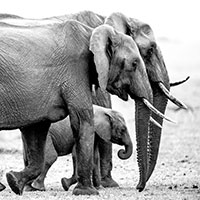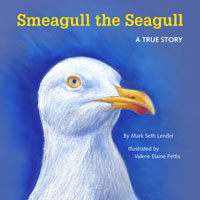Grizzly Politics
Air Date: Week of January 1, 1999
In Idaho, scientists and citizens are monitoring the state of the local grizzly bear population. Jyl Hoyt reports from member station K-B-S-U in Boise.
Transcript
CURWOOD: This is Living on Earth. I'm Steve Curwood. In the long-running battles over the Endangered Species Act, politics has always been at least as important as preservation, and it's no different today. Congress is considering major changes to the law, and the Clinton Administration is responding by moving to take a number of species off the Endangered Species List. Interior Secretary Bruce Babbitt says the goal is to show that the law works, as well as to squelch critics who contend that once a critter goes on the list it never comes off. Secretary Babbitt's delisting, as it's called, starts with a couple of dozen high-profile species, including the bald eagle, the gray wolf, and other so-called recovery success stories. One such story is set in Yellowstone National Park, where the grizzly bear could get delisted as early as next summer. But many scientists who study grizzlies in Yellowstone say that's a risky move. Jyl Hoyt from member station KBSU in Boise explains in this encore report.
(Clanking sounds)
HOYT: On the northern edge of Yellowstone National Park, a group of scientists and activists grab binoculars and spotting scopes and set out to look for grizzly bears.
SERVHEEN: Well, there is a sow and a couple of cubs working this area back here. We'll see if we can get on her.
HOYT: Back in 1975, when Federal scientists put the grizzly on the Endangered Species list, they thought the huge bear was going extinct. But Chris Servheen, who leads the government's recovery team, says the picture has changed dramatically.
SERVHEEN: We see the population increasing at 4%. We see bears in places we haven't seen them in 50 years. We see bears south of Jackson, Wyoming, that we never thought we would see.
HOYT: Mr. Servheen and his team, using statistical models, estimate there are now 400 to 500 grizzlies in the Yellowstone ecosystem.
SERVHEEN: The grizzly bear situation in Yellowstone is one of the greatest conservation success stories of the 20th century, certainly one of the best ones under the Endangered Species Act.
HOYT: It's such a success story that the Federal Government is now thinking of taking the grizzly bear off the Endangered Species list. But many independent scientists say that idea is premature. Pioneer grizzly researcher Lance Craighead believes there are perhaps a third fewer grizzly bears in the Yellowstone ecosystem than the government estimate, and barely more than when the bear was first protected.
CRAIGHEAD: Statistically it's not a significant increase. And so to talk about delisting them, without taking into account what's happening to their habitat, is really not supported by the facts.
HOYT: Mr. Craighead says the status of the bears' habitat and food supply is at least as important as their numbers.
(River water splashes)
HOYT: The 9,500 square-mile Yellowstone ecosystem is made up of Yellowstone and Teton National Parks and 6 national forests in 3 states: Idaho, Montana, and Wyoming.
(Splashing continues)
HOYT: Icy rivers cascade through the rich volcanic soils of the Yellowstone Plateau, creating nutritious grasses for elk and bison. These ungulates, as well as numerous plants, are food for Yellowstone grizzlies. When there are plenty of such foods, as there were during the 1980s, their populations rise, says Dave Matteson, a biologist with the US Geological Survey. But Mr. Matteson says the bison population is in trouble. Recent conflicts with local ranchers are forcing wildlife managers to drastically thin the herd.
MATTESON: We're standing to lose a good share of our bison because of a management plan that proposes to halve the herd and keep it that way.
(Footfalls)
HOYT: Mr. Matteson makes his way up a hill, checking for bear sign, and searching for plants that bears like to eat. He kneels down and digs up a spring beauty, a favorite bear food. Plants like these are still abundant here, but they're not the high-nutrition items grizzlies need most. And like the bison, other big ticket foods here are in trouble.
MATTESON: We're standing to lose a good share of the cutthroat trout because of lake trout that were unintentionally introduced into the lake.
HOYT: Mr. Matteson says the native trout swim up shallow streams where bears can catch them. But the introduced fish stay deep in Yellowstone Lake. And there are other problems.
MATTESON: Very likely we'll lose most of the white bark pine. Most of the army cutworm maws that the bears use on the eastern part of the ecosystem, both really important foods, due to global climate warming.
HOYT: Perhaps the biggest threat to bears here is roads: for oil and gas development, for logging, for subdivisions.
(An engine revs up, soil moves)
HOYT: Roads like this one being built north of the park are gobbling up grizzly bear habitat fast. Louisa Wilcox with Sierra Club's Grizzly Bear Ecosystem Project says if the 20 counties surrounding Yellowstone Park were taken together, it would be the fastest-growing state in the nation.
WILCOX: And what was once open space along the Madison, the Yellowstone, the Gallatin Rivers are filling up with subdivisions, with people moving into this area to get a piece of Paradise. And that in the long run is going to be a continued problem for grizzly bears. Ninety percent of the grizzly bears now that die, die as a result of conflicts that occur outside Yellowstone Park.
(Footfalls, voices)
HOYT: The group of bear-watchers moves from one hill in Yellowstone to another, seeing wolves, bison, elk, but still no bears. Carnivore ecologist Jim Halfpenny of the Institute for Arctic and Alpine Research says the importance of a healthy population of grizzlies in Yellowstone goes far beyond the bears themselves.
HALFPENNY: Anything we can do to benefit the grizzly bear is probably going to benefit a host of other species. If we provide good habitat for grizzly, that's providing good habitat for black bear, for wolves, for deer, for elk.
HOYT: Critics say that talk about delisting the grizzlies is being dictated by politics, not science. The Endangered Species Act is under heavy pressure from Congress. So Doug Honnald of the Earth Justice Legal Defense Fund says wildlife managers are scrambling to find ways to defend the law.
HONNALD: The Federal agencies want to use the grizzly bear as a success story, and they care more about the public perception of whether things are going well than about the hard reality out on the ground of: are bears doing well or not?
HOYT: If the government proposes this winter to take Yellowstone grizzly bears off the endangered species list, and most analysts say it will, Idaho, Montana, and Wyoming would manage the bears. These states have been antagonistic to grizzlies, and many environmentalists fear they won't be committed to maintaining a healthy population with enough rich habitat. But Chris Servheen of the US Fish and Wildlife Service says, if the bears' future is in doubt the government will put them back on the Endangered Species list.
SERVHEEN: We are committed to be adaptive managers. That means that as new problems arise, as new threats come about, as we learn new things, we will change our management and respond to those to meet the needs of the bear.
MAN: Got to get some cubs coming in here.
WOMAN: She's a little darling.
(Various voices)
MAN: A little bit this side of the edge.
HOYT: In Yellowstone Park's Lamar Valley, the bear-watchers finally get what they came for. The group ignores the sun setting into a dazzling golden sky, and the full moon rising, because finally a grizzly bear walks into view.
MAN: Yep. See her moving there.
WOMAN: Oh yeah, there she is.
(Another woman laughs)
MAN 2: Oh, wow.
MAN 3: Oh, beautiful.
HOYT: Huddled around a spotting scope, these activists say they'll continue to fight any move to delist the Yellowstone grizzlies, while the future of the bear's habitat remains uncertain. For Living on Earth, I'm Jyl Hoyt in Yellowstone National Park.
Living on Earth wants to hear from you!
Living on Earth
62 Calef Highway, Suite 212
Lee, NH 03861
Telephone: 617-287-4121
E-mail: comments@loe.org
Newsletter [Click here]
Donate to Living on Earth!
Living on Earth is an independent media program and relies entirely on contributions from listeners and institutions supporting public service. Please donate now to preserve an independent environmental voice.
NewsletterLiving on Earth offers a weekly delivery of the show's rundown to your mailbox. Sign up for our newsletter today!
 Sailors For The Sea: Be the change you want to sea.
Sailors For The Sea: Be the change you want to sea.
 The Grantham Foundation for the Protection of the Environment: Committed to protecting and improving the health of the global environment.
The Grantham Foundation for the Protection of the Environment: Committed to protecting and improving the health of the global environment.
 Contribute to Living on Earth and receive, as our gift to you, an archival print of one of Mark Seth Lender's extraordinary wildlife photographs. Follow the link to see Mark's current collection of photographs.
Contribute to Living on Earth and receive, as our gift to you, an archival print of one of Mark Seth Lender's extraordinary wildlife photographs. Follow the link to see Mark's current collection of photographs.
 Buy a signed copy of Mark Seth Lender's book Smeagull the Seagull & support Living on Earth
Buy a signed copy of Mark Seth Lender's book Smeagull the Seagull & support Living on Earth

